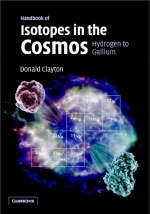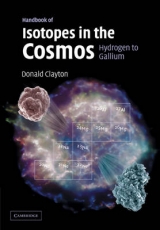
Handbook of Isotopes in the Cosmos
Hydrogen to Gallium
Seiten
2003
Cambridge University Press (Verlag)
978-0-521-82381-4 (ISBN)
Cambridge University Press (Verlag)
978-0-521-82381-4 (ISBN)
- Titel erscheint in neuer Auflage
- Artikel merken
Zu diesem Artikel existiert eine Nachauflage
Focusing on scientific knowledge, this Handbook of Isotopes in the Cosmos provides an information resource for scientists wishing to learn about the isotopes and their place in the cosmos. Suitable for astronomers, physicists, chemists, geologists and planetary scientists, complete with a glossary of essential technical terms.
Each naturally occurring isotope has a tale to tell about the history of matter, and each has its own special place in cosmic evolution. This volume aims to grasp the origins of our material world by looking at the abundance of the elements and their isotopes, and how this is interpreted within the theory of nucleosynthesis. Each isotope of elements from Hydrogen to Gallium is covered in detail. For each, there is an historical and chemical introduction, and a table of those isotopes that are abundant in the natural world. Information given on each isotope includes its nuclear properties, solar system abundance, nucleosynthesis in stars, astronomical observations, and isotopic anomalies in premolar grains and solar-system solids. The book is suitable for astronomers, physicists, chemists, geologists and planetary scientists, and contains a glossary of essential technical terms.
Each naturally occurring isotope has a tale to tell about the history of matter, and each has its own special place in cosmic evolution. This volume aims to grasp the origins of our material world by looking at the abundance of the elements and their isotopes, and how this is interpreted within the theory of nucleosynthesis. Each isotope of elements from Hydrogen to Gallium is covered in detail. For each, there is an historical and chemical introduction, and a table of those isotopes that are abundant in the natural world. Information given on each isotope includes its nuclear properties, solar system abundance, nucleosynthesis in stars, astronomical observations, and isotopic anomalies in premolar grains and solar-system solids. The book is suitable for astronomers, physicists, chemists, geologists and planetary scientists, and contains a glossary of essential technical terms.
Donald Clayton is Centennial Professor of Physics and Astronomy at Clemson University, South Carolina.
List of illustrations; Preface; Introduction; 1. Hydrogen (H); 2. Helium (He); 3. Lithium (Li); 4. Beryllium (Be); 5. Boron (B); 6. Carbon (C); 7. Nitrogen (N); 8. Oxygen (O); 9. Fluorine (F); 10. Neon (Ne); 11. Sodium (Na); 12. Magnesium (Mg); 13. Aluminium (Al); 14. Silicon (Si); 15. Phosphorous (P); 16. Sulphur (S); 17. Chlorine (Cl); 18. Argon (Ar); 19. Potassium (K); 20. Calcium (Ca); 21. Scandium (Sc); 22. Titanium (Ti); 23. Vanadium (V); 24. Chromium (Cr); 25. Manganese (Mn); 26. Iron (Fe); 27. Cobalt (Co); 28. Nickel (Ni); 29. Copper (Cu); 30. Zinc (Zn); 31. Gallium (Ga); Glossary.
| Erscheint lt. Verlag | 11.9.2003 |
|---|---|
| Zusatzinfo | 30 Tables, unspecified; 8 Line drawings, unspecified |
| Verlagsort | Cambridge |
| Sprache | englisch |
| Maße | 182 x 255 mm |
| Gewicht | 809 g |
| Themenwelt | Naturwissenschaften ► Chemie ► Anorganische Chemie |
| Naturwissenschaften ► Physik / Astronomie ► Astronomie / Astrophysik | |
| Technik ► Umwelttechnik / Biotechnologie | |
| ISBN-10 | 0-521-82381-1 / 0521823811 |
| ISBN-13 | 978-0-521-82381-4 / 9780521823814 |
| Zustand | Neuware |
| Haben Sie eine Frage zum Produkt? |
Mehr entdecken
aus dem Bereich
aus dem Bereich



